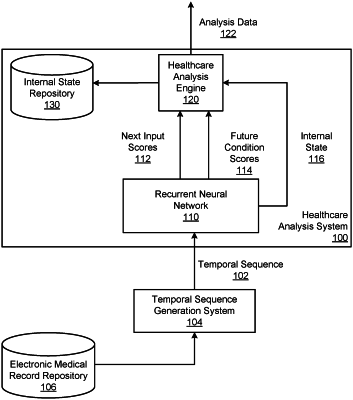| CPC G06N 3/047 (2023.01) [G06N 3/042 (2023.01); G06N 3/044 (2023.01); G06N 3/063 (2013.01); G16H 50/20 (2018.01); G06N 3/02 (2013.01); G06N 3/08 (2013.01)] | 20 Claims |

|
1. A method comprising:
obtaining a first temporal sequence of health events, wherein the first temporal sequence comprises respective health-related data associated with a particular patient at each of a plurality of time steps;
initializing a respective internal state for each of one or more recurrent neural network layers of a recurrent neural network;
for each of the plurality of time steps, processing the respective health-related data associated with the particular patient at the time step using the recurrent neural network, wherein the processing comprises updating the respective internal state of each of the one or more recurrent neural network layers of the recurrent neural network using the respective health-related data associated with the particular patient at the time step to generate a network internal state of the recurrent neural network for the time step;
generating, from the network internal state of the recurrent neural network after a last time step in the first temporal sequence, a neural network output for the first temporal sequence; and
generating, from the neural network output for the first temporal sequence, health analysis data that characterizes future health events that may occur after a last time step in the first temporal sequence.
|